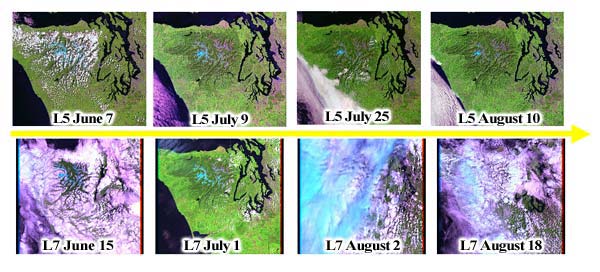|
|
|
Overview | Goal and Objectives | Components | Benefits | Information Overview In 2002, the U.S. Geological Survey (USGS) launched a program to enhance the acquisition, preservation, and use of remotely sensed data for USGS science programs, as well as for those of cooperators and customers. Remotely sensed data are fundamental tools for studying the Earth's land surface, including coastal and near-shore environments. For many decades, the USGS has been a leader in providing remotely sensed data to the national and international communities. Acting on its historical topographic mapping mission, the USGS has archived and distributed aerial photographs of the United States for more than half a century. Since 1972, the USGS has acquired, processed, archived, and distributed Landsat and other satellite and airborne remotely sensed data products to users worldwide. Today, the USGS operates and manages the Landsats 5 and 7 missions and cooperates with the National Aeronautics and Space Administration to define and implement future satellite missions that will continue and expand the collection of moderate-resolution remotely sensed data. In addition to being a provider of remotely sensed data, the USGS is a user of these data and related remote sensing technology. These data are used in natural resource evaluations for energy and minerals, coastal environmental surveys, assessments of natural hazards (earthquakes, volcanoes, and landslides), biological surveys and investigations, water resources status and trends analyses and studies, and geographic and cartographic applications, such as wildfire detection and tracking and as a source of information for The National Map. The program furthers these distinct but related roles by leading the USGS activities in providing remotely sensed data while advancing applications of such data for USGS programs and a wider user community. Goal and Objectives of the Land Remote Sensing Program The fundamental goal of the Land Remote Sensing Program (LRS) is to provide the Federal Government and the public with a primary source of remotely sensed data and applications and to take the lead in defining the future of land remote sensing, nationally and internationally. To accomplish this goal, the LRS Program is working to attain the following objectives:
The program encompasses three major components: Satellite Mission Operations, Long-Term Data Preservation and Access, and Remote Sensing Research and Data Utilization. Each component performs specific tasks to accomplish the program's fundamental mission and primary objectives. Satellite Mission Operations
As the archive's holdings expand, the collection becomes increasingly valuable for researchers working to understand natural resources, hazards, and long-term changes. The major focus of this component is to manage and preserve these data so that they remain accessible to a broad range of users over time. This entails using state-of-the-art transcription and archiving technologies, transferring the archives to new media as needed, investigating and implementing advanced media and data storage systems for long-term data preservation, and exploring new ways to make data accessible to customers and cooperators.
 These images were taken by Landsats 5 and 7 from June through August 2001. They illustrate why regular repeated coverage by multiple satellites is advantageous to ensure cloud-free images are acquired for users. Who Will Benefit? The LRS supports a global user community. Entities that will benefit include USGS and DOI programs that use remotely sensed data, including The National Map; other Government agency programs involved in remotely sensed data collection, analysis, and application and/or land management issues, environmental monitoring, and emergency response; the Landsat international ground station/archive network; the USGS business partner network and commercial value-added processors; and the worldwide user community involved in land remote sensing applications. For More Information For more information, please see our Land Remote Sensing Program Web site. Or, contact
Jay Feuquay U.S. Geological Survey National Center, Mail Stop 517 12201 Sunrise Valley Drive Reston, VA 20192-0002 Phone: 703-648-5057 |
|
U.S. Department of the
Interior ||
U.S. Geological Survey 12201 Sunrise Valley Drive, Reston, VA 20192, USA URL: http://geography.usgs.gov/lrs.html Maintainer: Geography Webmaster Last modified: 08:32:35 Fri 07 May 2004 |
 |
|
|